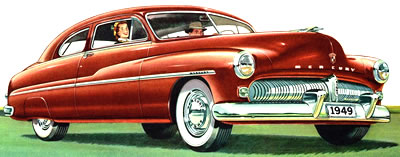 If you’ve seen the movie “Cobra,” starring Sylvester Stallone as a cop who loves to blow away everything and everyone, you’ve probably noticed the other star of the movie, a 1949 Mercury Sports Coupe. That this coupe – and other members of the Merc 9CM line appeared at all in 1949 – is thanks to the intense lobbying of Henry Ford’s Uncle Edsel who saw the need for a division to compete with General Motors mid-range. Ford Motor didn’t even come close to having any mid-range competitive edge as it had the base Ford and high-end Lincoln Divisions and nothing in between. To Edsel, it was obvious, the automaker needed another competitive division.
If you’ve seen the movie “Cobra,” starring Sylvester Stallone as a cop who loves to blow away everything and everyone, you’ve probably noticed the other star of the movie, a 1949 Mercury Sports Coupe. That this coupe – and other members of the Merc 9CM line appeared at all in 1949 – is thanks to the intense lobbying of Henry Ford’s Uncle Edsel who saw the need for a division to compete with General Motors mid-range. Ford Motor didn’t even come close to having any mid-range competitive edge as it had the base Ford and high-end Lincoln Divisions and nothing in between. To Edsel, it was obvious, the automaker needed another competitive division.
The 1949 Mercury Division – whose products were marketed as Fords with different names and a little upgrade – was actually the savior of the automaker as its Sport Coupe (Cobra’s futuristic – for the time – vehicle) brought buyers back in the mid-price range.
Suffice it to say, Mercury did have a full line, a convertible, two-door hardtop, conventional sedan and conventional coupe and suffice it further than they all did well. However, it’s the Sports Coupe that people remember.
Powered by Ford’s flathead V-8, the engine was bored and stroked to where it cranked out 255 horsepower for the Sport Coupe, which was about as much as you’ll get from any vehicle whose V-8 engine only runs with roughly a 6.8-to-one compression ratio. It could be mated to a three-speed manual or an automatic.
The 1949 Mercury, as typified by the Sports Coupe, was a very modern-looking car for that era. Rounded, the front end, which featured a minimal amount of chrome. The rounded hood worked nicely with the bulbous and rounded front fenders to give the front end a nicely completed, smooth look that flowed into a rounded body that carried the lines of the finders through the sloping rear quarters. The rounded hood flowed into the body panels and windshield and the slightly sloped windshield carried the line to the roof which sloped sharply back to a small, rounded trunk lid. The body also sported wheelwell covers to complete the look and there was a minimum of chrome.
The other memorable 49 Merc was the woodie wagon, also known as an Estate Wagon, that featured Mercury’s revamped styling. Interestingly, the woodie featured a distinct set of front fenders that were low on the vehicle and above which the rather noticeable hood was visible. The woodie did sport its own rather stylish road lamp/turn signals that were nicely integrated into the single round headlights that were fared into the fenders. The fenders on this and other lines that features similar styling, such as the convertible, also established the beltline about midway on the vehicle.
Under the hood, Mercury used the 255-horsepower flathead eight instead of adopting the inline six that Ford had developed. The inline six was nearly a match for the flathead eight and probably helped to hasten the development of the Ford X-Head V-8 in the next couple of years.
The Mercury lineup proved to be a hit with buyers and proved the marketing insight of Edsel. For 1949, total sales figures of all vehicles were nearly 300,000 vehicles. These sales alone established Mercury as a serious contender in the market.
